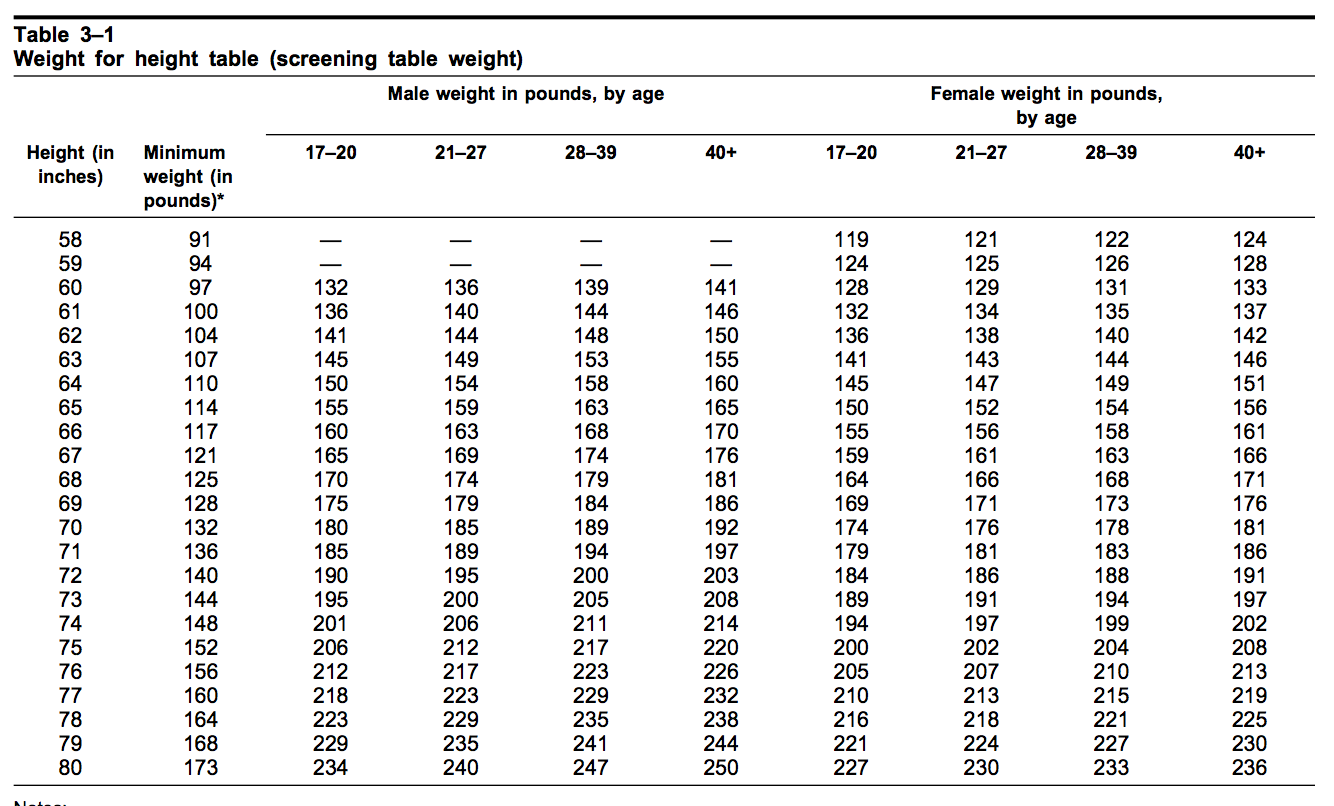The physical requirements for joining the army are not just about strength and endurance; they also encompass specific standards for weight and height. These metrics play a vital role in determining an individual's eligibility for service, ensuring that each soldier can meet the demands of military life. Understanding these standards is crucial for aspiring recruits and those interested in a military career.
When it comes to the army, weight and height standards are designed to ensure that all personnel can perform their duties effectively. These standards vary based on gender and age, taking into account the physical requirements of different roles within the army. The importance of adhering to these standards cannot be understated, as they are essential for maintaining a fit and capable fighting force.
In this article, we will explore the various aspects of army weight and height requirements, including their significance, how they are measured, and what potential recruits need to know before applying. Whether you are considering a career in the army or simply curious about military standards, this comprehensive guide to army weight and height will provide valuable insights.
What Are the Army's Weight and Height Standards?
The army has established specific weight and height standards to ensure that all personnel can meet the physical demands of their roles. These standards are based on body mass index (BMI) and are designed to promote a healthy and fit military force. The requirements differ for males and females and vary according to age groups. Here are the key points regarding the army's weight and height standards:
- Weight standards are based on height and age.
- Both male and female recruits have different weight limits.
- Height measurements are taken without shoes.
- Recruits must meet these standards to be eligible for enlistment.
Why Are Weight and Height Standards Important in the Army?
Weight and height standards serve several essential purposes within the military. They are not merely arbitrary numbers but are designed to ensure that all soldiers can perform effectively in a variety of situations. Here are some reasons why these standards are critical:
- **Operational Readiness:** Soldiers need to be physically fit to engage in rigorous training and combat situations.
- **Health and Safety:** Maintaining a healthy weight reduces the risk of injuries and medical issues.
- **Team Cohesion:** Uniformity in physical standards promotes teamwork and camaraderie among soldiers.
How Are Army Weight and Height Measured?
Measurements for height and weight are conducted during the enlistment process and periodically during service. Understanding how these measurements are taken can help recruits prepare adequately. Here's how it works:
- **Height:** Measured in inches or centimeters without shoes, standing straight against a wall or measuring device.
- **Weight:** Measured on a standard scale, typically in pounds or kilograms, with recruits wearing minimal clothing.
What Happens If You Don't Meet the Weight and Height Standards?
Failing to meet the army's weight and height standards can have significant consequences for potential recruits. Here are some possible outcomes:
- **Ineligibility for Enlistment:** Individuals who do not meet the standards may be disqualified from joining the army.
- **Waivers:** In some cases, waivers may be available for those who are close to the standards but require additional time to meet them.
- **Remedial Actions:** Current soldiers who exceed weight limits may face remedial training or be placed on a weight control program.
Can You Improve Your Weight and Height for the Army?
Improving your weight and height measurements for army enlistment is possible, but it requires dedication and a proper plan. Here are some tips for aspiring recruits:
- **Consult a Nutritionist:** A professional can help you develop a balanced diet tailored to your fitness goals.
- **Create an Exercise Routine:** Regular cardio and strength training will aid in weight management and overall fitness.
- **Stay Hydrated:** Drinking adequate water is essential for maintaining optimal physical performance.
What Are the Age-Specific Standards for Army Weight and Height?
Age plays a significant role in determining the acceptable weight and height standards for army recruits. The army has established different categories based on age groups, which allows for a fair assessment of physical readiness. Here’s a breakdown of the standards:
| Age Group | Height (inches) | Weight (pounds) |
|---|---|---|
| 17-20 | 60-80+ | 110-220 |
| 21-27 | 60-80+ | 110-220 |
| 28-39 | 60-80+ | 110-220 |
| 40+ | 60-80+ | 110-220 |
How Do Height and Weight Standards Affect Military Roles?
The army has various roles that require different physical capabilities. Height and weight standards can influence an individual's eligibility for certain positions. For example:
- **Combat Positions:** May require stricter adherence to standards due to the physical demands of the role.
- **Support Roles:** Might have more flexible standards, focusing on skill sets rather than strictly physical attributes.
Conclusion: The Importance of Meeting Army Weight and Height Standards
In summary, understanding army weight and height standards is crucial for anyone considering a career in the military. These metrics serve as a foundation for ensuring that all recruits can fulfill their roles effectively while promoting health and safety within the ranks. By preparing adequately and adhering to these standards, aspiring soldiers can enhance their chances of successful enlistment and a fulfilling military career.
A Glimpse Into The Life Of Alexis Bledel's Father
Unveiling The Life And Journey Of Joclyn Stine
Unveiling Jaime Lorente: The Elite Talent Of Our Time


